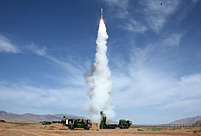The Chinese yuan, or renminbi, has made remarkable progress toward internationalization with the country's increased efforts to expand its use, but it still has a long way to go before going truly global, experts have said.
In September, the yuan jumped to ninth in the latest survey of Bank for International Settlements (BIS) on foreign-exchange turnover, with its daily trading more than tripling to 120 billion U.S. dollars from 34 billion U.S. dollars three years ago, when it was ranked the 17th most-actively traded.
The renminbi for the first time joined the ranks of the most-actively traded currencies. While only partially convertible, it has doubled over the past three years to 2.2 percent of global turnover.
"The role of the renminbi in global FX trading has surged, in line with increased efforts to internationalize the Chinese currency," the BIS said.
The Chinese government began cross-border settlements of its currency in 2009, and in 2012, the central bank announced that all Chinese companies could settle their trades in yuan and more directly swap foreign currencies with it. Now China has signed agreements with over 20 countries and regions to allow their currencies to be directly exchangeable.
China resumed treasury bond futures trading in early September, which will allow overseas T-bond holders to more easily hedge against risks in the rest of their investment portfolio, thus boosting the yuan's internationalization.
The much-anticipated Free Trade Zone (FTZ) in Shanghai, which serves as a test ground for financial reforms, is expected to herald further progress toward a fully convertible Chinese yuan.
Both international and domestic trade enterprises, financial institutions and logistics firms are expected to flood into the FTZ, which will boost yuan-based entrepot, offshore and cross-border trade.
"However, the rapid development of the yuan's internationalization, upon closer analysis, reveals the gap between the renminbi's international status and China's economic performance," said Chen Gong, chief researcher for Anbound Consulting.
According to the World Bank, China's GDP amounts for about 11.7 percent of the world's total, second only to the United States' 22.4 percent. However, in currency exchange, the U.S. dollar takes up about 43.7 percent while the renminbi only manages a slice of 1.1 percent.
"Among the top 10 most-actively traded currencies, the Chinese yuan is the only one whose foreign exchange share lags behind its GDP share," said Liu Dongliang, senior economist with China Merchants Bank.
"The internationalization of the renminbi still has a long way to go despite remarkable progress," Liu added.
Chris Leung, senior economist for the Development Bank of Singapore, attributed the lingering rein over capital flow and the fledgling domestic financial market to other countries' reluctance to widely use renminbi.
"More free capital flow and more financial reforms and innovations may aid the renminbi to further internationalize," Leung said.
It may take another 15 years before the yuan becomes a truly global currency as China needs to loosen restrictions on capital accounts and unify exchange rates for both on- and offshore markets, Li Lihui, chairman of the Bank of China, said at a top financial forum in June.
True globalization of the yuan should start at neighboring countries and regions and then expand to Asia and the rest of the world, Chen Yulu, member of the Chinese central bank's monetary policy committee, wrote in a report.
China should lift the proportion of yuan trade-settlement in the country's foreign trade, the proportion of yuan payments in the global clearing system and expand cross-border investment in yuan, according to Chen.
 Storms leave 97 dead, 58 missing in Mexico
Storms leave 97 dead, 58 missing in Mexico New model of indigenous surface-to-air missiles testfired
New model of indigenous surface-to-air missiles testfired  118.28-carat diamond to be auctioned in HK
118.28-carat diamond to be auctioned in HK Maternal love under streetlight
Maternal love under streetlight Naked foreign student sits in the middle of a road in Haikou
Naked foreign student sits in the middle of a road in Haikou  Colorful Yunnan: Enjoy the natural beauty
Colorful Yunnan: Enjoy the natural beauty Harbin named Chinese city with most beautiful women
Harbin named Chinese city with most beautiful women New college students' military training in Guangzhou
New college students' military training in Guangzhou Rugby girls
Rugby girls PLA's 38th Group Army conduct training
PLA's 38th Group Army conduct training Residences of the royal house of Savoy
Residences of the royal house of Savoy The last days of Wan Aihua
The last days of Wan Aihua Highlights at 12th National Games of China
Highlights at 12th National Games of China Beijing Film Academy welcomes freshmen
Beijing Film Academy welcomes freshmen Large mahjong party sets new world record
Large mahjong party sets new world recordDay|Week|Month